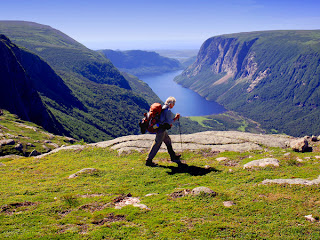Western Brook Pond to Gros Morne Mountain
Executive summary by darmansjah
Locals simply call this Montana-size island of serrated
granite 20 miles off the coast of Quebec "The Rock." And with more
than 10,000 miles of craggy coastline and only 12 people per square mile, The
Rock, Canada's easternmost point, is a backpacker's dream. The best route is
the five-day Long Range Traverse in 446,080-acre Gros Morne National Park
(GMNP), where you'll encounter edge-of-the-world views of coastal fjords
sparkling between 1,000-foot granite cliffs at every bend.
After a mandatory park orientation, drive 12 miles to the
trailhead at Western Brook Pond. Load up and walk the easy two-mile trail to
the shore of a freshwater fjord. Come with solid map-and-compass skills,
because there isn't a single trail marker along this 20-mile route, which is
packed with side trips and navigational puzzles. The meandering footpaths of
caribou draw you away from the proper course. Fog cloaks the highlands in June
and July. Five designated wilderness campsites, each a day's hike apart, line
the traverse in spruce groves tucked between knolls of heather and bare-bone
granite. For ocean views, side-hike to the cliffy edges of Ten Mile Pond and
Baker Brook Pond; for views of everything else, summit the 2,644-foot crumbling
granite dome of Gros Morne Mountain on your final day. Top out, then wind
downhill southwest to sea level and the park visitor center.
Permits
Reserve up to three months in advance ($25CDN/group, plus an
additional $85CDN/person for backcountry permits). (709) 458-2417;
pc.gc.ca/pn-np/nl/grosmorne
Map
National Topographic Series 12-H/12, ($12CDN, fedpubs.com)
Season
Gros Morne Adventures offers a six-day traverse for
$1,295CDN per person. grosmorneadventures.com
Round-Trip: 23 miles, 3 to 5 days
When to Go: Relatively low elevation means this route opens in June and
can be hiked until late September. But come prepared: The Long Range Mountains
are on the Gulf of St. Lawrence and take the brunt of some of the worst weather
in the world. Go with a guide service if you’re not an expert navigator.
This off-trail traverse takes you
from inland fjords lined with 2,000-foot-high granite cliffs draped with wispy
waterfalls deep into Gros Morne National Park. The rugged seaside plateau is
just one reason Newfoundland is the new mecca for adventure. The landscape here
is as dramatic as it is remote: It was carved by glaciers from massive,
uplifted blocks of granite that form the expansive plateau, a wild place still
loaded with moose and caribou. Good skills with map, compass, and GPS are
required here, as no marked or maintained trails penetrate this unique
wilderness. So wild is this trek that the park wardens won’t give you a permit
unless you carry a locator beacon (they call it a caribou collar). This ensures
they won’t have to search the whole park if you fail to emerge on time.
Insider Tip: The impenetrable alpine krummholz vegetation (called
tuckamore on Newfoundland) in Gros Morne is so dense it seriously complicates
navigation. One useful technique is to follow “caribou leads,” trails carved
through the tuck over centuries by moose and caribou. Then take a GPS waypoint
and adjust your vector as required when you pop out the other side.


No comments:
Post a Comment